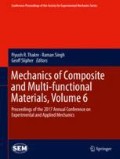Abstract
Fiber reinforced polymer composites are frequently used in hybrid structures where they are co-cured or co-bonded to dissimilar materials. For autoclave cured composites, this interface typically forms at an elevated temperature that can be quite different from the part’s service temperature. As a result, matrix shrinkage and CTE mismatch can produce significant residual stresses at this bi-material interface. This study shows that the measured critical strain energy release rate, Gc, can be quite sensitive to the residual stress state of this interface. If designers do not properly account for the effect of these process induced stresses, there is danger of a nonconservative design. Tests including double cantilever beam (DCB) and end notched flexure (ENF) were conducted on a co-cured GFRP-CFRP composite panel across a wide range of temperatures. These results are compared to tests performed on monolithic GFRP and CFRP panels.
Access this chapter
Tax calculation will be finalised at checkout
Purchases are for personal use only
References
Camanho, P.P., Davila, C.G., Moura, M.F.D.: Numerical simulation of mixed-mode progressive delamination in composite materials. J. Compos. Mater. 37(16), 1415–1438 (2003)
Li, S., et al.: Mixed-mode cohesive-zone models for fracture of an adhesively bonded polymer–matrix composite. Eng. Fract. Mech. 73(1), 64–78 (2006)
Sun, C.T., Jin, Z.H.: Modeling of composite fracture using cohesive zone and bridging models. Compos. Sci. Technol. 66(10), 1297–1302 (2006)
Yang, Q., Cox, B.: Cohesive models for damage evolution in laminated composites. Int. J. Fract. 133(2), 107–137 (2005)
Nairn, J.A.: Energy release rate analysis for adhesive and laminate double cantilever beam specimens emphasizing the effect of residual stresses. Int. J. Adhes. Adhes. 20(1), 59–70 (2000)
Yokozeki, T., Ogasawara, T., Aoki, T.: Correction method for evaluation of interfacial fracture toughness of DCB, ENF and MMB specimens with residual thermal stresses. Compos. Sci. Technol. 68(3–4), 760–767 (2008)
Warnock, C., Briggs, T.: Cure Cycle Development and Qualification for Thick Section Composites. SAMPE, Long Beach (2016)
International, A: Standard Test Method for Mode I Interlaminar Fracture Toughness of Unidirectional Fiber-Reinforced Polymer Matrix Composites. ASTM International, West Conshohocken (2013)
Brown, A.A., et al.: Modeling Interfacial Fracture in Sierra. Sandia National Laboratories, Livermore (2013)
ASTM: Standard Test Method for Determination of the Mode II Interlaminar Fracture Toughness of Unidirectional Fiber-Reinforced Polymer Matrix Composites. ASTM International, West Conshohocken (2014)
Carlsson, L.A., Gillespie, J.W., Pipes, R.B.: On the analysis and design of the End Notched Flexure (ENF) specimen for mode II testing. J. Compos. Mater. 20(6), 594–604 (1986)
Fenner, J.S.: Damage Tolerance Enhancement of Carbon Fiber Reinforced Polymer Composites by Nanoreinforcement of Matrix, in Theoretical and Applied Mechanics. Northwestern University, Evanston (2014)
SIERRA SolidMechanics Team: SIERRA/SolidMechanics 4.38 User’s Guide. Sandia National Laboratories, Albuquerque (2015)
Velmurugan, R., Gurusideswar, S.: Strain rate dependent behavior of glass/nano clay filled epoxy resin composite. Def. Sci. J. 64(3), 295–302 (2014)
Gurusideswar, S., Velmurugan, R., Gupta, N.K.: High strain rate sensitivity of epoxy/clay nanocomposites using non-contact strain measurement. Polymer. 86, 197–207 (2016)
Mallick, P.: Fiber-Reinforced Composites: Materials, Manufacturing, and Design. Marcel Dekker, Inc, New York (1993)
Hanson, A., et al.: Experimental measurement and finite element analysis of residual stresses in simple composite structures. CAMX 2016, Anaheim (2016)
Nelson, S., Werner, B.: Experimental and computational investigations into the effect of process induced stresses on the mode I fracture toughness of composite materials. CAMX 2016, Anaheim (2016)
Acknowledgement
Sandia National Laboratories is a multi-mission laboratory managed and operated by Sandia Corporation, a wholly owned subsidiary of Lockheed Martin Corporation, for the U.S. Department of Energy’s National Nuclear Security Administration under contract DE-AC04-94AL85000.
Author information
Authors and Affiliations
Corresponding author
Editor information
Editors and Affiliations
Rights and permissions
Copyright information
© 2018 Springer International Publishing AG
About this paper
Cite this paper
Werner, B.T., Nelson, S.M., Briggs, T.M. (2018). Effect of Process Induced Stresses on Measurement of FRP Strain Energy Release Rates. In: Thakre, P., Singh, R., Slipher, G. (eds) Mechanics of Composite and Multi-functional Materials, Volume 6. Conference Proceedings of the Society for Experimental Mechanics Series. Springer, Cham. https://doi.org/10.1007/978-3-319-63408-1_16
Download citation
DOI: https://doi.org/10.1007/978-3-319-63408-1_16
Published:
Publisher Name: Springer, Cham
Print ISBN: 978-3-319-63407-4
Online ISBN: 978-3-319-63408-1
eBook Packages: EngineeringEngineering (R0)

